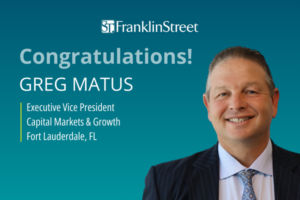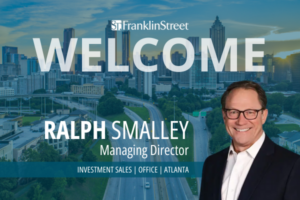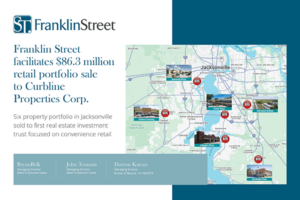The forward-looking technology landscape and the growing regulatory environment are reshaping the vital ways in which insurance companies engage with customers, especially in the U.S., the largest insurance market in terms of premium dollars in the world. Adjusting to changes is the answer for Franklin Street Insurance Services Director Ted Holler.
Now is the time for insurance companies to adopt more digital practices. The need to remain competitive after several years in which the commercial insurance market has been soft is critical. But insurance and risk management specialist Ted Holler believes CRE asset owners and managers enjoy favorable market conditions. Specializing in all commercial product types, Holler speaks about business owners’ concerns regarding increased digitization, the role of InsurTech space in reshaping the insurance industry in the years to come, as well as the impact of possible changes in the tax system.
CPE: How would you characterize the commercial insurance environment in recent years?
Ted Holler: Without question, the commercial insurance market could be described as “soft” over the past few years. Except for auto liability, it’s been a buyer’s market with decreasing rates, broadened coverages, and lower deductibles. Some initial first quarter 2017 reports indicate that rates have leveled off across the industry. That’s a bit misleading, though. Our clients are still seeing strong decreases on both CAT and non-CAT property as well as general liability for insureds with good losses. Those decreases are being offset, industry-wide, by increases in other lines like management, professional, and cyber liability. Overall, CRE asset owners and managers should still be enjoying very favorable market conditions.
CPE: According to a PwC 2017 Insurance CEO survey, insurance is the industry most affected by disruptive change. There is a high percentage of CEOs who are extremely concerned about the threats to their growth prospects from the speed of technological change, changing customer behavior and competition from new market entrants. How serious do you think this problem is?
Holler: This would be a huge problem for any organization or industry that is slow or refuses to embrace change. But I don’t see that to be the case for the insurance industry, especially not here at Franklin Street. Our industry has always been dependent upon data. With increased digitization and new technology there is now greater access to new and more powerful data. If anything, the industry has shown itself to be eager and well positioned to adopt new technologies that better leverage data.
In regards to consumer behavior, I think it’s been the industry’s slower response to these changes that opened the door to so many new entrants. Most other industries have already adjusted to changes in consumer behavior while insurance seems to have lagged. That said, whether it be through internal development, acquisition, or in partnership with these new entrants, much of the industry can close the gaps in consumer experience, technology, and data utilization that the new entrants seek to exploit.
CPE: What is the InsurTech space? How does it help the insurance industry?
Holler: Just like Fintech was coined to describe an emerging sector in financial services, InsurTech is a label given to a sector of the insurance industry in which technological innovation is employed to improve customer experience, reduce costs, and increase efficiency and profitability. Examples might be apps that let a consumer compare and analyze insurance options from smart devices. Tools that track and transmit data to insurance companies for use in developing more tailored and competitive offerings (e.g. Progressive’s Snapshot) are another example. Lemonade, another app, is unique in that it “pools” premiums of insureds with common interests for potential payment of excess premiums to a good cause. These and other innovations are great for the industry because they bring fresh ideas to a space that, according to many consumers, is in dire need of a makeover.
CPE: What kind of analysis would you recommend to a new client that is reaching out to you for an insurance? What are the most frequent mistakes businessmen tend to make?
Holler: Take the time to select a broker partner who is a true insurance professional and expert in your field. Insurance is often viewed as a commodity, but not all carriers are the same. Not all policy forms are the same. And not all brokers or agents are the same. A broker that specializes in your field will better understand your needs, goals, and objectives. Furthermore, a niche specialist is more familiar with the policy forms and endorsements and can better craft a tailored contract. Finally, a broker that is dealing exclusively in your business will have better relationships with underwriters and knowledge of key carriers and their capabilities and appetites. Thus, they will be able to negotiate a better deal on your behalf. Almost all agents and brokers have access to the same carrier markets and information, but it’s what certain brokers can do with those markets and information that allows an insured to get the best program possible.
CPE: The new party at the White House is reconsidering regulatory reform, trade policy and the tax system. How could this impact the insurance industry in the future?
Holler: With any new administration, there is going to be uncertainty. It’s still too early to predict the effects of any changes, but President Trump’s executive order to create regulatory reform task forces is a promising step in the direction of eliminating bureaucratic red-tape that can be a hindrance to job and business growth, key drivers for healthy economy and insurance industry. In theory, President Trump’s trade policies would protect and strengthen U.S. companies. The U.S. is the largest insurance market in terms of premium dollars, making up nearly 30 percent of total global premiums. So, again, this could be a promising development for the insurance industry. That said, the global economy is much more interconnected than it used to be, and there are concerns that the administration’s policies might do more harm than good at the global level.
The timeline on tax reform appears to be getting pushed back, but judging by both the “Trump Proposal” and the House of Representatives’ budget blueprint, U.S. corporations are poised to benefit from significantly reduced corporate tax rates, including U.S. P&C carriers, with those having a greater volume of domestic written premium getting a greater relative lift. Real estate investors also stand to benefit greatly from the proposed tax plans. This is not surprising given Trump’s business background.
CPE: You are an experienced risk management and commercial property & casualty insurance professional. What do you expect to happen in the insurance industry in the years to come?
Holler: In the short-term, from a rate and competition standpoint, it’s hard to tell. Barring a series of catastrophic natural disasters or an economic downturn, I see the market remaining soft for core lines like property and liability. But the market is cyclical, so it’s just a matter of time before it firms up. With insurance, unlike many other industries, the profitability of any one year’s dealings may not be known for years to come. So, there will be a correction after an extended period of falling rates and hyper-competition once the losses, and possibly other factors, catch up.
Longer term, I’d expect InsurTech to play a big role in reshaping the industry, initially in personal lines and small business. The good news for commercial real estate owners, investors, and managers is that the property market remains well capitalized and capable of withstanding significant loss, with new vehicles bringing in more capacity daily. The current administration appears to be fostering a very business-friendly environment and innovation is generating novel product offerings and making the industry more responsive to consumer needs.



